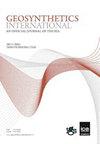Dynamic properties of frozen rubber-reinforced expansive soils under confining pressure
IF 3.3
2区 工程技术
Q2 ENGINEERING, GEOLOGICAL
引用次数: 0
Abstract
In recent years, waste rubber has been increasingly utilized to enhance the performance of expansive soil foundations. This study aims to investigate the influence of rubber powder on the dynamic characteristics of frozen rubber-reinforced expansive soils (RRES) in permafrost regions. Temperature-controlled dynamic triaxial tests were conducted on RRES samples, varying rubber content, freezing temperatures, and confining pressures. The key findings are as follows: (1) A modified Hardin model with freezing temperature and rubber content as correction factors was established, which was verified to be useful for describing the dynamic stress-strain relationship. (2) Under the confining pressure, the dynamic shear modulus decreases with increasing rubber content. When the rubber content changes from 5% to 10%, the dynamic shear modulus decreases by about 20 MPa; the change becomes less obvious after the content exceeds 20%, and the RRES tends to show the characteristics of rubber. (3) As the rubber content increases, the damping ratio rises and shows the phenomenon of increasing and then decreasing with increasing confining pressure, and reaching a maximum at 0.4 MPa; (4) A prediction model for the maximum dynamic shear modulus with rubber content, freezing temperature and confining pressure is proposed.围压作用下冻结橡胶加固膨胀土动力特性研究
近年来,废橡胶被越来越多地用于提高膨胀土地基的性能。研究了橡胶粉对冻土区橡胶加筋膨胀土动力特性的影响。在不同橡胶含量、冻结温度和围压条件下,对RRES试样进行了温控动态三轴试验。主要研究成果如下:(1)建立了以冻结温度和橡胶含量为修正因子的修正Hardin模型,验证了该模型能较好地描述动态应力-应变关系。(2)围压下,动剪切模量随橡胶掺量的增加而减小。当橡胶含量从5%变化到10%时,动剪切模量降低约20 MPa;含量超过20%后变化不明显,RRES趋于表现出橡胶的特性。(3)随着橡胶掺量的增加,阻尼比增大,并随围压的增加呈现先增大后减小的现象,在0.4 MPa时达到最大值;(4)建立了含胶量、冻结温度和围压对最大动剪切模量的影响预测模型。
本文章由计算机程序翻译,如有差异,请以英文原文为准。
求助全文
约1分钟内获得全文
求助全文
来源期刊

Geosynthetics International
ENGINEERING, GEOLOGICAL-GEOSCIENCES, MULTIDISCIPLINARY
CiteScore
6.90
自引率
20.00%
发文量
91
审稿时长
>12 weeks
期刊介绍:
An online only, rapid publication journal, Geosynthetics International – an official journal of the International Geosynthetics Society (IGS) – publishes the best information on current geosynthetics technology in research, design innovation, new materials and construction practice.
Topics covered
The whole of geosynthetic materials (including natural fibre products) such as research, behaviour, performance analysis, testing, design, construction methods, case histories and field experience. Geosynthetics International is received by all members of the IGS as part of their membership, and is published in e-only format six times a year.
 求助内容:
求助内容: 应助结果提醒方式:
应助结果提醒方式:


